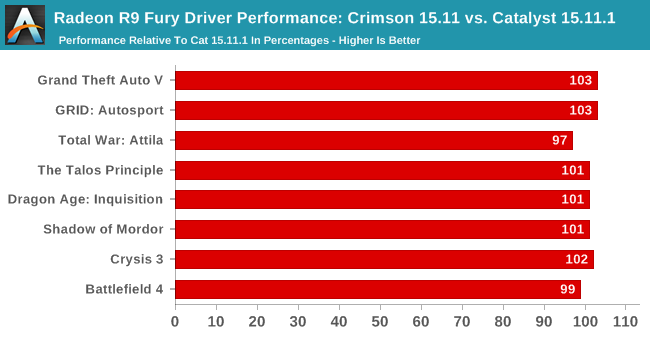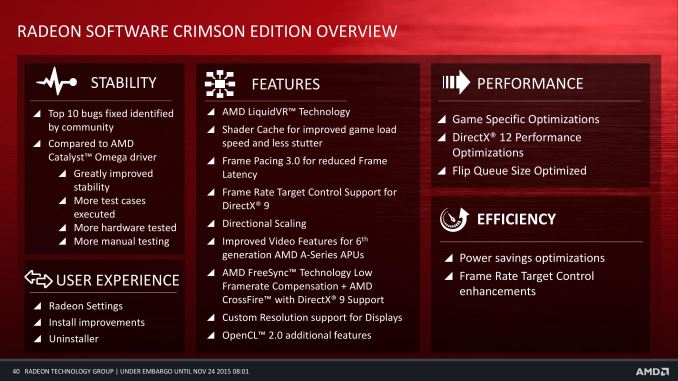AMD's Radeon Software Crimson Driver Released: New Features & A New Look
by Ryan Smith & Daniel Williams on November 24, 2015 8:00 AM ESTCrimson Performance
Last but certainly not least, let’s talk about performance improvements. Like the Omega driver before it, Crimson comes with a collection of performance improvements from AMD’s new driver branch. To preface this with caution, I don’t think anyone should be expecting massive system-wide performance gains – that’s all low-hanging fruit AMD picked long ago – but there’s plenty of room for some lesser optimizations along with game-specific optimizations.
AMD’s own numbers point to game-specific improvements of up to 20%, though it should be noted that AMD’s best-case numbers are on unreleased/beta games that have yet to be well-optimized in the first place. Otherwise AMD’s own numbers are far more tame, listing recently released games with gains between three and five percent.
To take a quick look at general performance, we went ahead and ran our GPU benchmark suite at 2560x1440 on our Radeon R9 Fury (vanilla), comparing the previous Catalyst 15.11.1 beta to the new Radeon Software Crimson 15.11 beta. The Fury and its underlying Fiji GPU is the newest product out of AMD, so it offers AMD the best opportunity to unlock any remaining performance in the architecture.

Overall the average performance gain at 2560x1440 is just 1%. There are a couple of instances where there are small-but-consistent performance gains – Grand Theft Auto V and Grid: Autosport stand out here – but otherwise the performance in our other games is within the margin of error, plus or minus. Not that we were expecting anything different as this never was pitched as a golden driver, but this does make it clear that more significant performance gains are going be on a per-game basis.
Final Thoughts
Wrapping things up, AMD’s development structure in the past year and going forward is one that has both been beneficial to the company and has brought with it its own drawbacks. By focusing feature releases around the end of the year driver, AMD is able to cut down on what parts of the driver they change (and thereby can possibly break) at other times of the year, and try to knock out all of their feature-related bugs at once. At the same time it makes the annual driver release a significant event, as AMD releases a number of new features all at once. However on the other hand this means that AMD has few features launching any other time of the year, which can make it look like they’re not heavily invested in feature development at those points. Then of course there’s the WHQL element, where for multiple reasons AMD hasn’t issued very many WHQL releases this year, and is something they’re seeking to change in 2016.
Looking under the hood there’s no single feature that’s going to blow every Radeon user away at once, but overall there are a number of neat features here that should be welcomed by various user groups. The Freesync Low Framerate Compensation changes should be of particular interest to Freesync users, while shader caching will improve shader loading performance across the board. Otherwise smaller fixes like the DirectX 9 improvements to CrossFire frame pacing, CrossFire Freesync, and framerate target control should be welcome news to APU and dual graphics users.
Meanwhile AMD’s radical overhaul of their control panel via the new Radeon Settings application will be quickly noticed by everyone. Though there’s plenty of room for interpretation on style and just how a good control panel is laid out, AMD has clearly put a lot of effort into cleaning up the layout of their control panel and it shows, as important options are no longer buried under multiple layers of menu trees. And on the performance front Radeon Settings is faster than Catalyst Control Center even on fast machines, and though we haven’t spent much time on covering it, AMD has also managed to speed up the installation process while they were at it. So all-told the Crimson release has something for everyone.
Ultimately I hesitate to ascribe too much of this to the Radeon Technologies Group too soon – this project has clearly been in the works longer than 3 months – but at the same time this is the RTG making their mark. It’s a new direction for AMD’s graphics group and a new look to match. And if the RTG can meet their stability, performance, and release goals going forward with the new Crimson driver, then they should be able to make 2016 a good year for the Radeon user base.


















146 Comments
View All Comments
piroroadkill - Wednesday, November 25, 2015 - link
Wrong. The page says the new driver supports the R5 230, but it's actually a TeraScale 2 card!This is a scandal that no website seems to have picked up on.
silverblue - Wednesday, November 25, 2015 - link
...but I thought all cards from the 5000 series onwards were supported in this driver release?tamalero - Thursday, December 3, 2015 - link
pretty sure that they are "supported". You just wont see improvements of bug fixes anymore.tipoo - Tuesday, November 24, 2015 - link
Well that's a lot more than a facelift! Interested in game load time and frame pacing tests vs Nvidia instead of vs themselves.WaltC - Tuesday, November 24, 2015 - link
Good write up...nVidia's been playing catch-up lately, though--especially with HBM technology, D3d12 support in hardware, etc. It's an old joke that nVidia engineering is always playing catch-up to nVidia PR...;) Nice driver interface...What nVidia calls "new drivers" released for new games, AMD usually calls "hotifxes"--but this year they'll probably join nVidia and release a new driver for every AAA title that ships--which is all pretty much PR-fluff, imo. There are certain marketing devices that nVidia uses that I hope AMD remains blessedly free of.Michael Bay - Tuesday, November 24, 2015 - link
Catch up to what? HBM matters nothing with nV still holding the perf crown with DDR.Then their own HMC architecture comes out and it`s even more of an uphill battle for AMD.
jasonelmore - Tuesday, November 24, 2015 - link
Each Game Ready Driver is not fluff, they have SLI profiles buddragonsqrrl - Wednesday, November 25, 2015 - link
Nice spin XDBateluer - Tuesday, November 24, 2015 - link
Hmm, I have an AM1 based Athlon 5350 machine. Will need to check out the Crimson drivers on it.Jaytn - Tuesday, November 24, 2015 - link
The video settings on web video actually does work for me.Only did a quick check, but a website i know uses mp4 (h.264) works and a video YouTube didnt convert to its new VP9 (using video/mp4; codecs="avc1.4d401e) did work as well. Only VP9 Youtube didnt work which makes sense i guess since afaik there are (close to) none hardware decoders out there yet and so naturally the VP9 video wouldnt be funneled through AMD's pipeline.
Maybe you could recheck if it works for you the same way?
My specs for reference:
Phenom II x6 1075T, HD6870, Radeon Settings Version 2015.1118.123.2413, Chrome 47.0.2526.69 beta-m, youtu.be/V20qDMpKARk (as a reference of a youtube video using mp4)
Actually quite nice to see how flawlessly it works on my now legacy 6870, props to AMD to not dropping right before this update but rather right after!
Other than that very nice review, esp on the technical details which im always very curious about!